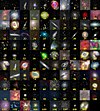Saturn Nebula
|
Planetary Nebula Data of the Saturn Nebula |
|
|---|---|

|
|
| The Saturn Nebula captured by the Hubble Space Telescope . | |
| AladinLite | |
| Constellation | Aquarius |
|
Position equinox : J2000.0 |
|
| Right ascension | 21h 04m 10.8s |
| declination | -11 ° 21 ′ 48 ″ |
| Appearance | |
| Apparent brightness (visual) | 8.0 likes |
| Apparent brightness (B-band) | 8.3 mag |
| Angular expansion | 0.58 ′ × 0.58 ′ |
| Central star | |
| designation | HIP 103992 |
| Apparent brightness | 11.5 likes |
| Physical data | |
| Redshift | -0.000 155 |
| Radial velocity | -46.6 km / s |
| distance | 2400 ly |
| history | |
| discovery | William Herschel |
| Date of discovery | September 7, 1782 |
| Catalog names | |
| NGC 7009 • PK 37-34.1 • GC 4628 • H IV 1 • h 2098 • CS = 11.5 • Lalande 40765 • Struve 8 • Caldwell 55 | |
The Saturn Nebula ( NGC 7009) is a planetary nebula in the constellation Aquarius . It has an apparent magnitude of +8.30 mag and a diameter of 0.5 '× 0.4'. It was discovered by William Herschel on September 7, 1782 , and was given the name Saturn Nebula by Lord Rosse , because the shape of the jets emerging from the sides is reminiscent of Saturn's rings .
Its distance is 2400 light years (according to Hynes), over 2900 light years (according to Sky Catalog) and 3900 light years (according to Burnham adopts O'Dell).
Visual observation
The Saturn Nebula NGC 7009 can already be seen as a stellar object in small telescopes with an opening of approx. 60 mm. In a larger telescope with about 10 "aperture, NGC 7009 is already very noticeable, even if both the structures and the two jets are extremely difficult to observe and only under the best conditions.
The image on the left shows that the Saturn Nebula and its both jets are well within the photographic range of inexpensive amateur equipment.
Web links
- Hubble Space Telescope
- NGC 7009: The Saturn Nebula - Astronomy Picture of the Day of December 30, 1997 (English).
- NOAO
- Antilhue Chile
- ESO: The strange structures in the Saturn Nebula + map, photos & animations from September 27, 2017

